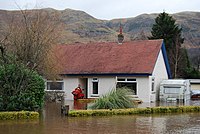River Devon, Clackmannanshire: Difference between revisions
Created page with "right|thumb|350px|The Devon in the Ochil Hills File:River Devon - geograph.org.uk - 1758105.jpg|right|thumb|250px|The Devo..." |
m →Course |
||
| Line 9: | Line 9: | ||
Upper areas have been dammed, creating Upper Glendevon, Lower Glendevon and Castlehill reservoirs.<ref name="Gaz">{{cite web|url=http://www.scottish-places.info/features/featurefirst93.html|title=Devon, River|publisher=Gazetteer for Scotland|accessdate=24 August 2014}}</ref> | Upper areas have been dammed, creating Upper Glendevon, Lower Glendevon and Castlehill reservoirs.<ref name="Gaz">{{cite web|url=http://www.scottish-places.info/features/featurefirst93.html|title=Devon, River|publisher=Gazetteer for Scotland|accessdate=24 August 2014}}</ref> | ||
The Devon then flows east and southeast through Glendevon, turning southwest at [[Crook of Devon]] in [[Kinross-shire]], | The Devon then flows east and southeast through Glendevon, turning southwest at [[Crook of Devon]] in [[Kinross-shire]], where (as the village's name suggests) it takes a sharp turn, and then continuing westwards, meandering across its flood plain along the foot of the Ochil Hills. It reaches the [[River Forth]] to the west of [[Alloa]] at the small village of [[Cambus, Clackmannanshire|Cambus]]. | ||
==History and culture== | ==History and culture== | ||
Latest revision as of 16:46, 9 February 2015


The River Devon is a tributary of the River Forth which flows through three counties; Perthshire, Kinross-shire and Clackmannanshire, in which county it discharges into the Forth.
Course
The source of the river is in Perthshire, on the slopes of Blairdenon Hill in the Ochil Hills at an altitude of 1800 feet.
Upper areas have been dammed, creating Upper Glendevon, Lower Glendevon and Castlehill reservoirs.[1]
The Devon then flows east and southeast through Glendevon, turning southwest at Crook of Devon in Kinross-shire, where (as the village's name suggests) it takes a sharp turn, and then continuing westwards, meandering across its flood plain along the foot of the Ochil Hills. It reaches the River Forth to the west of Alloa at the small village of Cambus.
History and culture
During the Reformation, William Kirkcaldy destroyed the bridge at Tullibody in attempt to prevent French troops retreating to the Siege of Leith at the end of January 1560. However, the French took down the roof of Tullibody Kirk to bridge the Devon.[2]
The Devon was surveyed by James Watt in 1766, who claimed that by deepening the river bed it might be navigable as far as Dollar. The estimated cost of such a project was £2,000.
The Devon Valley Railway was built alongside the river valley.
Robert Burns
Robert Burns wrote two lyrical songs about the river:
- The Banks of the Devon and
- Fairest Maid on Devon Bank
These were written in 1787, and recall Charlotte Hamilton of Mauchline whom he had met at nearby Harviestoun estate.[1] (Charlotte went on to marry Burns's friend, Adair.)
Flooding
Clackmannanshire Council has recognised the threat of flooding along the Devon and has worked to address the issue on its own account and in partnership with others, including the Worldwide Fund for Nature. Works undertaken on the Devon catchment include willow walling, riverside woodland and the blocking of wetland drains.[3]

In January 2008 the Devon catchment area was 'Very Wet'. Land became saturated and rainfall resulted in run-off into rivers, reaching the river system very quickly. River flows in the region were 'Exceptionally High'. Upstream, all the Ochil reservoirs were full with Castlehill reservoir overflowing for all of that month. The flood at the upstream gauge at Castlehill was the second highest recorded. Further downstream, the water level recorded at Glenochil was the highest since records began in 1956.

Over the period of 25 - 26 January 2008, residential and commercial properties in part of Tillicoultry were inundated.[4] The extent of flooding was greater than had been experienced in the past and the Council appointed specialist hydrological consultants to investigate the contributory factors and advise on measures available to minimise or eliminate any future occurrence. [5]
In November 2008 and again in November 2009 extensive flooding occurred in the Hillfoots making several road bridges across the river impassable. No houses were damaged on those two occasions.
Outside links
- "Forth District Salmon Fishery Board"
- "River Forth Fisheries Trust"
- WWF Scotland's natural flood management demonstration site
- SEPA Indicative River & Coastal Flood Map - Tillicoultry
- SEPA Indicative River & Coastal Flood Map - Alva
- SEPA Indicative River & Coastal Flood Map - Menstrie
References
- ↑ 1.0 1.1 "Devon, River". Gazetteer for Scotland. http://www.scottish-places.info/features/featurefirst93.html. Retrieved 24 August 2014.
- ↑ Knox, John, History of the Reformation, Book 3, e.g., Lennox, Cuthbert, ed., (1905), 191.
- ↑ Comment by Councillor Eddie Carrick on the Ochils Landscape Partnership and Sustainability: http://www.clacksweb.org.uk/document/2321.pdf
- ↑ BBC News report of flooding in Tillicoultry http://news.bbc.co.uk/1/hi/scotland/7242586.stm
- ↑ Clackmannanshire Council, Report to Council of 5th June 2008: Flooding in Tillicoultry: http://www.clacksweb.org.uk/document/meeting/1/258/2533.doc